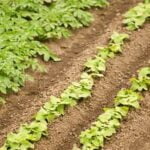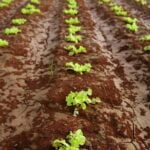Zone 6 vegetable gardening, which includes areas with a cold winter climate and moderately warm summers, presents its own unique set of challenges and advantages. Understanding the specific characteristics of Zone 6 is crucial for a successful vegetable garden. This article will cover everything you need to know to thrive in this particular zone.
When it comes to zone 6 vegetable gardening, choosing the right vegetables is essential for a bountiful harvest. Certain crops are better suited for the cooler temperatures and shorter growing season typical of Zone 6, and we’ll explore which ones are best for this climate. Additionally, preparing your soil properly is crucial for the success of your vegetable garden in Zone 6. We will discuss how to optimize your soil for healthy plant growth.
In addition to planting the right vegetables and prepping your soil, understanding best practices for planting in Zone 6 is vital for a thriving garden. Knowing when to plant, how deep to sow seeds, and proper spacing can make all the difference in the productivity of your vegetable garden. We will also delve into seasonal maintenance tips to keep your garden flourishing year-round.
And lastly, we’ll cover how to handle common pests and diseases that may be specific to Zone 6. So let’s get started on uncovering the secrets to successful vegetable gardening in Zone 6.
Choosing the Right Vegetables for Zone 6
When it comes to choosing the right vegetables for zone 6 vegetable gardening, it’s important to consider the climate and temperature patterns in this specific zone. Zone 6 typically experiences cold winters with an average minimum temperature of – 10 to 0 degrees Fahrenheit, and warm summers with an average maximum temperature of 70 to 80 degrees Fahrenheit.
This means that not all vegetables will thrive in this zone, but there are plenty of options to choose from that are well-suited to these conditions.
Cold-Hardy Vegetables
In zone 6, it’s crucial to select vegetables that can withstand cold temperatures and even frost. Some excellent choices for cold-hardy vegetables include cabbage, broccoli, cauliflower, Brussels sprouts, kale, spinach, lettuce, carrots, beets, radishes, and peas. These vegetables can be planted early in the season and are capable of surviving late frosts.
Heat-Tolerant Vegetables
While zone 6 may experience cool temperatures at the beginning and end of the growing season, the summer months can bring hot weather. It’s essential to select heat-tolerant vegetables that can thrive in these conditions. Some great options for heat-tolerant vegetables in zone 6 include tomatoes, peppers, eggplant, cucumbers, zucchini, squash, green beans, and sweet potatoes.
Short-Season Varieties
Given the relatively short growing season in zone 6 due to potential frost dates on both ends of the summer months, choosing short-season varieties can help ensure a successful harvest. Look for varieties that have a shorter time to maturity or those specifically bred for northern climates. This is especially important for heat-loving crops like tomatoes and peppers as they need enough time to mature before the first fall frost hits.
By carefully selecting cold-hardy vegetables, heat-tolerant varieties ,and short-season options you can enjoy a bountiful harvest while creating a thriving vegetable garden in zone 6.
Preparing Your Soil for Zone 6 Vegetable Gardening
When it comes to zone 6 vegetable gardening, preparing your soil is crucial to the success of your crops. The right soil composition can provide the essential nutrients and moisture retention needed for healthy plant growth. Here are some important steps to take when preparing your soil for zone 6 vegetable gardening:
1. Test Your Soil: Before making any adjustments to your soil, it’s important to test its pH level and nutrient content. You can purchase a soil testing kit or send a sample to a local extension office for analysis. This will help you determine if any amendments are needed to optimize your soil for vegetable gardening.
2. Amend the Soil: Depending on the results of your soil test, you may need to make certain amendments to improve its quality. Adding organic matter such as compost or well-rotted manure can help improve drainage, water retention, and overall fertility. Additionally, you may need to adjust the pH level by adding lime or sulfur.
3. Till the Soil: Once you have added any necessary amendments, it’s important to thoroughly till the soil to incorporate these materials and create a loose, aerated growing medium. This will also help break up compacted layers and promote better root development for your vegetables.
By taking these steps to prepare your soil, you can create an optimal growing environment for your zone 6 vegetable garden. Remember that each type of vegetable may have specific requirements, so be sure to research individual plant needs before planting in your prepared soil.
Best Practices for Planting in Zone 6
When it comes to successful zone 6 vegetable gardening, proper planting practices are essential for ensuring a bountiful harvest. Here are some best practices to keep in mind when planting your vegetable garden in zone 6:
- Start with a plan: Before you start planting, create a garden plan that includes the layout of your vegetable beds, the types of vegetables you want to grow, and their specific planting dates. This will help you stay organized and make the most of your available space.
- Choose the right location: Select a sunny spot for your vegetable garden as most vegetables require at least 6-8 hours of direct sunlight per day. Avoid areas with poor drainage or where water tends to pool, as this can lead to root rot and other issues.
- Proper spacing: When planting your vegetables, be sure to follow the recommended spacing guidelines for each type of plant. Crowding can lead to competition for nutrients and water, resulting in stunted growth and decreased yield.
In addition to these best practices, it’s important to consider succession planting and crop rotation in your zone 6 vegetable garden. Succession planting allows you to stagger the planting of certain crops to ensure a continuous harvest throughout the growing season. Crop rotation helps prevent soil-borne diseases and improves soil fertility by rotating different types of crops in a specific sequence.
By following these best practices for planting in zone 6, you can set yourself up for a successful and productive vegetable garden that will provide you with fresh produce throughout the growing season.
Seasonal Maintenance
Spring and Summer Maintenance
In Zone 6, spring and summer are prime times for gardening. During these seasons, it’s important to keep up with regular watering, especially as the temperatures rise. Mulching around your plants can help retain moisture in the soil and reduce the frequency of watering. It’s also crucial to keep an eye out for weeds and remove them promptly to prevent them from competing with your vegetables for nutrients.
Fall Maintenance
As the weather begins to cool down in Zone 6, it’s time to start preparing for the fall and winter months. Consider planting cold-hardy vegetables for a late-season harvest, such as carrots, beets, spinach, and kale.
It’s also essential to protect your garden from potential frost by covering sensitive plants or bringing them indoors if necessary. Additionally, cleaning up any plant debris and adding compost to your soil will help prepare it for the following growing season.
Winter Maintenance
Even though it may seem like there isn’t much happening in the garden during the winter months, there are still some steps you can take to ensure a successful growing season next year. Consider using row covers or cold frames to extend your vegetable growing season through the winter.
You can also use this time to plan and prepare for your next planting season by organizing your garden layout, ordering seeds, and repairing any gardening tools or equipment that may need attention. By staying proactive during the winter, you’ll set yourself up for a thriving garden when spring arrives.
By staying on top of seasonal maintenance tasks throughout the year in Zone 6 vegetable gardening, you’ll be better equipped to handle any challenges that come your way while enjoying a bountiful harvest of fresh vegetables.
Dealing With Common Pests and Diseases in Zone 6
When it comes to zone 6 vegetable gardening, dealing with common pests and diseases is an inevitable part of the process. However, with the right knowledge and preparation, you can minimize the impact of these issues on your garden.
One common pest in zone 6 is the Colorado potato beetle, which can quickly decimate a potato crop if left unchecked. To prevent infestations, regularly inspect the undersides of potato leaves for bright orange eggs and handpick any beetles or larvae you find.
Another common issue in zone 6 vegetable gardens is powdery mildew, a fungal disease that affects a wide range of plants including cucumbers, squash, and pumpkins. To combat powdery mildew, avoid overhead watering to reduce humidity levels, and plant resistant varieties whenever possible. Additionally, treating plants preventatively with organic fungicides like neem oil can help control the spread of this disease.
Despite your best efforts, some pests and diseases may still take hold in your zone 6 vegetable garden. In these cases, it’s important to have an arsenal of natural and organic remedies at your disposal. For example, introducing beneficial insects like ladybugs or lacewings can help keep aphid populations in check without resorting to chemical pesticides.
| Common Pest/Disease | Preventative Measures |
|---|---|
| Colorado Potato Beetle | Regular inspection and handpicking eggs and larvae |
| Powdery Mildew | Avoid overhead watering, plant resistant varieties, use organic fungicides like neem oil |
Harvesting and Storing Your Vegetables in Zone 6
When it comes to harvesting and storing your vegetables in Zone 6, timing is key. Each vegetable has its own ideal time for harvesting, and getting this right can make a huge difference in the flavor and texture of your produce.
In Zone 6, the average first frost date is around mid-October, so it’s important to keep an eye on the weather and plan your harvest accordingly. Some vegetables like carrots, parsnips, and kale actually benefit from a light frost, which can improve their flavor.
Once you’ve harvested your vegetables, proper storage is crucial to maintaining their freshness. Root vegetables such as potatoes, carrots, and beets should be stored in a cool, dark place with good ventilation to prevent them from rotting. Onions and garlic also need to be cured before they are stored in a well-ventilated area. Leafy greens like lettuce and spinach should be washed and dried before being stored in the refrigerator.
In addition to traditional methods of storing vegetables such as root cellars or refrigeration, many Zone 6 gardeners have found success with freezing or canning their excess produce for long-term storage. Investing in a freezer or learning proper canning techniques can help you enjoy your homegrown vegetables throughout the year. By taking the time to properly harvest and store your vegetables in Zone 6, you can enjoy the fruits of your labor long after the gardening season has ended.
Success Stories
In conclusion, successful zone 6 vegetable gardening requires a good understanding of the unique climate and growing conditions of this region. By choosing the right vegetables that are suitable for zone 6, preparing the soil properly, and following best practices for planting, gardeners can ensure a bountiful harvest. Seasonal maintenance is also crucial for year-round gardening success, and gardeners should be prepared to deal with common pests and diseases that may affect their crops.
Experienced gardeners in zone 6 have shared valuable tips and insights for successful vegetable gardening. Their stories highlight the importance of planning and preparation, as well as the benefits of adapting to the specific challenges of gardening in this zone. By learning from these success stories, novice gardeners can gain valuable knowledge and inspiration for their own gardening endeavors.
Frequently Asked Questions
What Vegetables Can Be Grown in Zone 6?
Zone 6 is suitable for growing a variety of vegetables including beets, carrots, lettuce, peas, potatoes, radishes, and spinach. These vegetables thrive in the cooler temperatures of this zone.
What Is the Difference Between Zone 6a and 6b?
The main difference between Zone 6a and 6b lies in the average minimum winter temperatures. Zone 6a has colder winters with minimum temperatures between -10 to -5 degrees Fahrenheit, while Zone 6b has slightly milder winters with minimum temperatures between -5 to 0 degrees Fahrenheit.
Is Zone 6 Good for Gardening?
Zone 6 can be good for gardening as it experiences distinct seasons with cold winters and warm summers. This allows for a diverse range of plants to be grown throughout the year, making it a favorable location for gardening enthusiasts.

If you’re looking to get into vegetable gardening, or are just looking for some tips on how to make your current garden better, then you’ve come to the right place! My name is Ethel and I have been gardening for years. In this blog, I’m going to share with you some of my best tips on how to create a successful vegetable garden.





